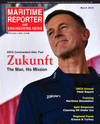
Page 50: of Maritime Reporter Magazine (March 2015)
U.S. Coast Guard Annual
Read this page in Pdf, Flash or Html5 edition of March 2015 Maritime Reporter Magazine
U.S. COAST GUARD ANNUAL
Forward Deployed Patrol Boat Os
While a part of the Department of Homeland
Defense, the Coast Guard is a military force with a global presence, with bilateral and multi-lateral agreements with over twenty-nine maritime na- tions in the Caribbean and in Central and South
America to help conduct Coast Guard missions of law enforcement, ? sheries protection, search and rescue and environmental and pollution response
Like the U.S. Navy coastal patrol boats (PCs) in the Arabia Gulf, the six forward deployed Coast
Guard 110-foot patrol boats (WPBs) are operating in a high threat environment every day conducting
VBSS (visit, board, search and seizure) boarding and “approach and assist” engagements with the many ? shing and trading dhows. Until the mission was turned over to the Iraqi Navy in 2011, PCs and the WPBs also protected the large oil terminal plat- forms in the northern gulf, and they still conduct various types of maritime infrastructure protec- tion, freedom of navigation exercises, and escorts of high-value units. Compared to stateside WPBs, the forward deployed cutters assigned to US Coast
Guard Patrol Forces Southwest Asia in Bahrain have twice the “op tempo,” meaning more days at sea. Speaking at the Surface Navy Association symposium, Zukunft said that the same patrol boat squadron model being employed in Bahrain would be very bene? cial in Central America.
The Coast Guard frequently worked with the
Navy to embark USCG law enforcement detach- ments (LEDETS) on USN ships supporting coun-
USCG patrol boats forward deployed to the Arabian Gulf. ter drug operations for the Joint Interagency Task
Force South at Key West, operating in the Carib- bean and eastern paci? c. But the last U.S. Navy
The Coast Guard Cutter Polar Star, a heavy ice-
Oliver Hazard Perry class deployment is under breaker homeported in Seattle, breaks a paral- way now, and the Navy’s presence in the region lel channel in the ice beside a previous channel near the National Science Foundation’s McMur- will be reduce, along with the opportunity to vary do Station, Antarctica in January 2015. As the the LEDETS. To pick up that mission, the Coast area of broken ice widens, southerly winds will
Guard will have to deploy more ships.
push the ice out to sea, allowing supply vessels to deliver cargo to McMurdo Station.
Icebreakers
Ironically, the diminishment of multi-year ice in (USCG photo by Petty Of

 49
49

 51
51
